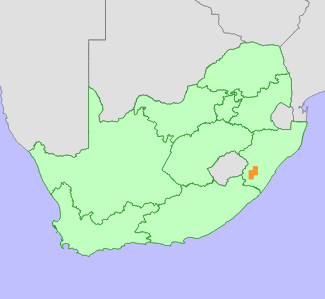|
Scientific Name | Asclepias concinna (Schltr.) Schltr. |
Higher Classification | Dicotyledons |
Family | APOCYNACEAE |
Synonyms | Gomphocarpus concinnus Schltr. |
National Status |
Status and Criteria | Critically Endangered C2a(i) |
Assessment Date | 2016/01/19 |
Assessor(s) | A. Nicholas, C.R. Scott-Shaw, L. von Staden & I.M. Johnson |
Justification | A very rare species, with only three, possibly four, small, isolated remaining subpopulations. The largest subpopulation consists of about 50 mature individuals, and the population numbers fewer than 200 mature individuals, and continue to decline due to ongoing habitat loss and degradation. |
Distribution |
Endemism | South African endemic |
Provincial distribution | KwaZulu-Natal |
Range | KwaZulu-Natal Midlands to Maclear. |
Habitat and Ecology |
Major system | Terrestrial |
Major habitats | Mooi River Highland Grassland, Southern KwaZulu-Natal Moist Grassland, Drakensberg Foothill Moist Grassland |
Description | Montane grassland, in annually burnt grassland, 900-1500 m. |
Threats |
| Most of this species' habitat has already been lost to timber plantations, crop cultivation, and spreading rural settlements. Remaining grassland fragments are often severely overgrazed, leading to a loss of species diversity. Habitat loss and degradation continues - two out of the three known subpopulations are impacted by grazing, and potentially threatened by development and expanding rural settlements. The third subpopulation is in a nature reserve, but there are land claims on the reserve, and it may revert to communal rangelands if the land claim is granted. Spreading, unmanaged alien invasive plants, particularly in areas near timber plantations, are also causing ongoing habitat degradation. |
Population |
An extremely rare species, known from only a few collections. It was collected once in the Eastern Cape more than 100 years ago, and not seen again in this area since. It was collected for the first time in more than 60 years in the 1980s, and for a long time this was the only known subpopulation. It is not certain whether this subpopulation survives, as its habitat has been planted up with timber plantations, and remaining fragments are highly degraded. Recently, three small, isolated subpopulations have been found within a small area in the KwaZulu-Natal Midlands and Drakensberg foothills. The largest subpopulation consist of about 50 plants, while the other two each have about 10 plants each. This species inconspicuous and easily overlooked, and it is possible that other subpopulations may still be found, but as most of this species' habitat has been irreversibly modified and fragmented, they are also likely to be confined to small, isolated fragments.
|
Population trend | Decreasing |
Assessment History |
Taxon assessed |
Status and Criteria |
Citation/Red List version | | Asclepias concinna (Schltr.) Schltr. | CR C2a(i) | 2017.1 | | Asclepias concinna (Schltr.) Schltr. | VU D2 | Raimondo et al. (2009) | | Asclepias concinna (Schltr.) Schltr. | EN B1B2c | Scott-Shaw (1999) | | Asclepias concinna (Schltr.) Schltr. | Endangered | Hilton-Taylor (1996) | |
Bibliography |
Hilton-Taylor, C. 1996. Red data list of southern African plants. Strelitzia 4. South African National Botanical Institute, Pretoria.
Nicholas, A. 1982. Taxonomic studies in Asclepias (Asclepiadeae) with particular reference to the narrow-leaved species in southern Africa. University of Natal.
Nicholas, A. 1999. A taxonomic reassessment of the subtribe Asclepiadinae (Asclepiaceae) in Southern Africa. Unpublished Ph.D., University of Durban-Westville, Durban.
Raimondo, D., von Staden, L., Foden, W., Victor, J.E., Helme, N.A., Turner, R.C., Kamundi, D.A. and Manyama, P.A. 2009. Red List of South African Plants. Strelitzia 25. South African National Biodiversity Institute, Pretoria.
Scott-Shaw, C.R. 1999. Rare and threatened plants of KwaZulu-Natal and neighbouring regions. KwaZulu-Natal Nature Conservation Service, Pietermaritzburg.
|
Citation |
| Nicholas, A., Scott-Shaw, C.R., von Staden, L. & Johnson, I.M. 2016. Asclepias concinna (Schltr.) Schltr. National Assessment: Red List of South African Plants version 2024.1. Accessed on 2025/11/12 |
 Comment on this assessment
Comment on this assessment


